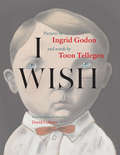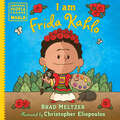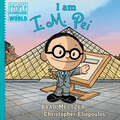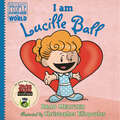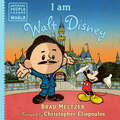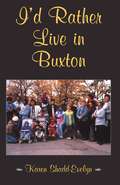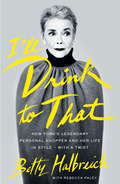- Table View
- List View
I Will Find You: The Love Story of the Year that will steal your heart away (Seal Island #2)
by Daniela SacerdotiA woman on the run. An island of secrets. A love to defy all odds...From the bestselling author of WATCH OVER ME, Daniela Sacerdoti's new novel is a romantic, heartrending, epic story that will sweep you away to the beautiful, mysterious island of Seal. If you love the novels of Rosanna Ley, Tracy Rees and Lulu Taylor, you will adore Daniela Sacerdoti.** Over 1 million copies sold of Daniela Sacerdoti's novels **Two different women, divided by time, bound by fate...After her beloved mother dies, Cora is heartbroken. When she discovers her mother has left her a cottage - a crumbling shelter on a remote and beautiful Scottish island - Cora hopes that travelling there will help her feel closer to the person she has lost. The moment she arrives on the wild, windswept island of Seal, Cora instantly falls under its spell. She is drawn to Innes, recently returned to the island to confront his past.As Cora begins to unravel her mother's connection to Seal, she learns the island has a dark, turbulent history. She is not the first lonely traveller to have sought refuge at Gealach Cottage. And there may be far more to her attraction to Innes than she could have ever imagined...Readers love the breathtaking novels of Daniela Sacerdoti:'A page-turning mystery... A love story that will satisfy even the most hopeless romantics' Daily Express on Keep Me Safe'Beautifully written, and the descriptions of Seal were so realistic I could almost hear the sea and the wind. A great book - Lesley Pearse on Keep Me Safe 'Emotional. Mysterious. I couldn't put it down' Daily Mail on Keep Me Safe'I fell in love with this book' Prima magazine on Keep Me Safe'Beautifully written and atmospheric' The Sun on Keep Me Safe'One of my favourite reads of the year so far. If there's such a thing as book heaven, this wonderfully original, poignant read deserves a place there' Shari Low, Daily Record on Watch Over Me'A beautiful story of love, loss, discovering one's true abilities and, above all, never forgetting who you really are' Debbie Flint on Take Me Home'A story of love, loss, hope and pastures new. I give this book 5 out of 5' A Lover of Books on Set Me Free'Dani's writing pulled me in... It reminded me of the safety of those arms around you as a young child when something scares you' Jera's Jamboree on Don't Be Afraid
I Wish
by Toon TellegenBestelling Dutch children's author Toon Tellegen matches 33 imaginative prose-poems prompted by the statement "I wish" with luminous, old-fashioned portraits by Ingrid Godon in this beautiful, unique volume perfect for thoughtful young readers.I Wish pairs writing with a gallery of portraits inspired by old-fashioned photographs - faces staring out at us with the serious, veiled expressions of a bygone time. Scattered among the paintings are young children, men and women, and babies, speaking through Toon Tellegen's yearning language. Like dozens of confessions poured from the page, the writing presents a glittering kaleidoscope of wishes, from imagined feats of heroism to reciprocated human love.
I Wrote This For You
by Iain Thomas Jon Ellis Pleasefindthis"I need you to understand something. I wrote this for you. I wrote this for you and only you. Everyone else who reads it, doesn't get it." Started 2007, I Wrote This For You is an acclaimed exploration of hauntingly beautiful words, photography and emotion that's unique to each person that reads it. This book gathers together nearly 200 of the most beautiful entries into four distinct chapters; Sun, Moon, Stars, Rain. Together with several new and exclusive entries that don't appear anywhere else, each chapter of I Wrote This For You focuses on a different facet of life, love, loss, beginnings and endings.
I Wrote This For You: 2007 - 2017
by Iain S. ThomasI need you to understand something. Ten years ago, I started writing this for you. I wrote it for you and only you. Since then, millions of other people have read it, but none have understood it the way you understand it. I set out to find you a long time ago and today, I'm so glad I finally have. Thank you for reading these words.
I am Frida Kahlo (Ordinary People Change the World)
by Brad MeltzerThe famous Mexican painter Frida Kahlo is the 23rd hero in the New York Times bestselling picture book biography series from Brad Meltzer and Christopher Eliopoulos (Cover may vary) This friendly, fun biography series focuses on the traits that made our heroes great--the traits that kids can aspire to in order to live heroically themselves. Each book tells the story of an icon in a lively, conversational way that works well for the youngest nonfiction readers and that always includes the hero's childhood influences. At the back are an excellent timeline and photos. This book features Frida Kahlo, the renowned Mexican painter and activist. After surviving a bus crash, she made her mark in art history for her unique way of looking at the world and integrating her own image and life into her paintings.This friendly, fun biography series inspired the PBS Kids TV show Xavier Riddle and the Secret Museum. One great role model at a time, these books encourage kids to dream big. Included in each book are: • A timeline of key events in the hero&’s history • Photos that bring the story more fully to life • Comic-book-style illustrations that are irresistibly adorable • Childhood moments that influenced the hero • Facts that make great conversation-starters • A virtue this person embodies: Frida Kahlo's self-love is celebrated in this title You&’ll want to collect each book in this dynamic, informative series!
I am I. M. Pei (Ordinary People Change the World)
by Brad MeltzerThe world-renowned architect I. M. Pei is the twenty-fourth hero in the New York Times bestselling picture book biography series. (Cover may vary)This friendly, fun biography series focuses on the traits that made our heroes great--the traits that kids can aspire to in order to live heroically themselves. Each book tells the story of an icon in a lively, conversational way that works well for the youngest nonfiction readers and that always includes the hero's childhood influences. At the back are an excellent timeline and photos. This book features I. M. Pei, the award-winning Chinese American architect whose projects include the John F. Kennedy Library and the pyramid at the Louvre. Included is a pop-up of the Louvre to help young readers see the space and Pei's design in 3D!This friendly, fun biography series inspired the PBS Kids TV show Xavier Riddle and the Secret Museum. One great role model at a time, these books encourage kids to dream big. Included in each book are: • A timeline of key events in the hero&’s history • Photos that bring the story more fully to life • Comic-book-style illustrations that are irresistibly adorable • Childhood moments that influenced the hero • Facts that make great conversation-starters • A virtue this person embodies: I. M. Pei's ingenuity led him and his designs to brave new heights. You&’ll want to collect each book in this dynamic, informative series!
I am Jim Henson (Ordinary People Change the World)
by Brad Meltzer<p>We can all be heroes. That’s the inspiring message of this New York Times bestselling picture book biography series from historian and author Brad Meltzer. This volume focuses on Jim Henson, the creator of the Muppets and Sesame Street. <p>This friendly, fun biography series focuses on the traits that made our heroes great--the traits that kids can aspire to in order to live heroically themselves. Jim Henson, for example, was always dreaming up something new, and always expressing his belief in the goodness of people. Henson was a born performer with a terrific sense of humor, and he used those talents to help create two of the most beloved programs in television history: The Muppet Show and Sesame Street. Through his Muppets, Jim showed the world that there’s nothing more beautiful than imagination, especially when it’s accompanied by laughter and kindness.</p>
I am Leonardo da Vinci (Ordinary People Change the World)
by Brad MeltzerThe famous Renaissance artist and inventor Leonardo da Vinci is the twentieth hero in the New York Times bestselling picture book biography series. (Cover may vary) This friendly, fun biography series focuses on the traits that made our heroes great--the traits that kids can aspire to in order to live heroically themselves. Each book tells the story of an icon in a lively, conversational way that works well for the youngest nonfiction readers and that always includes the hero's childhood influences. At the back are an excellent timeline and photos. This book features Leonardo da Vinci, the Renaissance artist and inventor. He always followed his interests, no matter where they led! His quest to fly led him to study birds' wings and his invention designs were the very earliest sketches of helicopters and other flying machines. Da Vinci's hard work and dedication to his curiosities is why we still remember him today.This friendly, fun biography series inspired the PBS Kids TV show Xavier Riddle and the Secret Museum. One great role model at a time, these books encourage kids to dream big. Included in each book are: • A timeline of key events in the hero&’s history • Photos that bring the story more fully to life • Comic-book-style illustrations that are irresistibly adorable • Childhood moments that influenced the hero • Facts that make great conversation-starters • A virtue this person embodies: Leonardo da Vinci's creativty is seen in everything he accomplished in his life You&’ll want to collect each book in this dynamic, informative series!
I am Lucille Ball (Ordinary People Change the World)
by Brad MeltzerIn this sixth entry in the New York Time Bestselling biography series, humor is the heroic trait, and modern icon Lucille Ball is celebrated. (Cover may vary) Lucille Ball could make any situation funny. By making people around the world laugh, she proved that humor can take on anything. She never changed how she behaved to seem "proper," even when other people pressured her to. By remaining true to who she was, she made her mark in comedy and television—even becoming the first female CEO of a major Hollywood studio! This friendly, fun biography series inspired the PBS Kids TV show Xavier Riddle and the Secret Museum. One great role model at a time, these books encourage kids to dream big. Included in each book are: • A timeline of key events in the hero&’s history • Photos that bring the story more fully to life • Comic-book-style illustrations that are irresistibly adorable • Childhood moments that influenced the hero • Facts that make great conversation-starters • A virtue this person embodies: Lucille Ball's humor and how it carried her to success is highlighted here. You&’ll want to collect each book in this dynamic, informative series!
I am Walt Disney (Ordinary People Change the World)
by Brad MeltzerThe 18th picture book in the New York Times bestselling series of biographies about heroes tells the story of Walt Disney, who made dreams come true. (Cover may vary)This friendly, fun biography series focuses on the traits that made our heroes great--the traits that kids can aspire to in order to live heroically themselves. Each book tells the story of one of America's icons in a lively, conversational way that works well for the youngest nonfiction readers and that always includes the hero's childhood influences. At the back are an excellent timeline and photos. This volume features Walt Disney, who makes dreams come true for himself and countless kids around the world. Walt Disney used his imagination and creativity to tell stories that have become beloved by families everywhere. From his failures to his successes, this book celebrates the work and the man behind the happiest place on earth.This friendly, fun biography series inspired the PBS Kids TV show Xavier Riddle and the Secret Museum. One great role model at a time, these books encourage kids to dream big. Included in each book are: • A timeline of key events in the hero&’s history • Photos that bring the story more fully to life • Comic-book-style illustrations that are irresistibly adorable • Childhood moments that influenced the hero • Facts that make great conversation-starters • A virtue this person embodies: Walt Disney's innovation is celebrated in this biography You&’ll want to collect each book in this dynamic, informative series!
I dieci film di Bond più belli…di tutti i tempi! #10: Operazione Tuono
by Mark Williams Alexander PowellI dieci film di Bond più belli...di tutti i tempi! Non ci vuole molto ad essere più soggettivi di così. O più divertenti! Unisci all'autore di bestseller internazionali Mark Williams per un viaggio alla scoperta del fenomeno di James Bond e scopri cosa ha portato l'autore a posizionare al decimo posto nella sua lista il film Operazione Tuono.
I sold Andy Warhol (too soon)
by Richard PolskyIn early 2005, Richard Polsky decided to put his much-loved, hard-won Warhol Fright Wig, up for auction at Christie's. The market for contemporary art was robust and he was hoping to turn a profit. His instinct seemed to be on target: his picture sold for $375,000. But if only Polsky had waited . . . Over the next two years, prices soared to unimaginable heights with multimillion-dollar deals that became the norm and not the exception. Buyers and sellers were baffled, art dealers were bypassed for auction houses, and benchmark prices proved that trees really do grow to the sky. Had the market lost all reason? InI Sold Andy Warhol (Too Soon), Polsky leads the way through this explosive, short-lived period when the "art world" became the "artmarket. " He delves into the behind-the-scenes politics of auctions, the shift in power away from galleries, and the search for affordable art in a rich man's playing field. Unlike most in the art world, Polsky is not afraid to tell it like it is as he negotiates deals for clients in New York, London, and San Francisco and seeks out a replacement for his lost Fright Wig in a market that has galloped beyond his means. A compelling backdoor tell-all about the strange and fickle world of art collecting,I Sold Andy Warhol (Too Soon) takes an unvarnished look at how the industry shifted from art appreciation to monetary appreciation.
I'd Know That Voice Anywhere: My Favorite NPR Commentaries
by Frank DefordFrank Deford is one of the most beloved sports journalists in America. A contributing writer to Sports Illustrated for more than fifty years, and a longtime correspondent on Real Sports with Bryant Gumbel, these days, Deford is perhaps best known for his weekly commentaries on NPR’s "Morning Edition.” Since 1980, Deford has recorded 1,600 of them, and in I’d Know That Voice Anywhere he brings together the very best, creating a charming, insightful, and wide-ranging look at athletes and the world of sports.In I’d Know That Voice Anywhere, Deford discusses everything from sex scandals and steroids to why, in a culture dominated by celebrity, sport is the only field on earth where popularity and excellence thrive in tandem. This page-turning compendium covers more than thirty years of sports history while showcasing the vast range of Deford’s interests and opinions, including his thoughts on the NCAA, why gay athletes "play straight,” and why he’s worried about living in an economy that is so dominated by golfers. A rollicking sampler of one of NPR’s most popular segments, I’d Know That Voice Anywhere is perfect for sports enthusiasts-as well as sports skeptics-and a must-read for any Frank Deford fan.
I'd Rather Be Reading: A Library of Art for Book Lovers
by Guinevere de la MareA compendium of delightful essays, poems, photos, quotations, and illustrations for book lovers.For anyone who’d rather be reading than doing just about anything else, this ebook is the ultimate must-have. In this visual ode to all things bookish, readers will get lost in page after page of beautiful contemporary art, photography, and illustrations depicting the pleasures of books. Artwork from the likes of Jane Mount, Lisa Congdon, Julia Rothman, and Sophie Blackall is interwoven with text from essayist Maura Kelly, bestselling author Gretchen Rubin, and award-winning author and independent bookstore owner Ann Patchett. Rounded out with poems, quotations, and aphorisms celebrating the joys of reading, this lovingly curated compendium is a love letter to all things literary, and the perfect thing for bookworms everywhere.
I'd Rather Live in Buxton
by Karen Shadd-EvelynWhen current and former residents of Buxton gather for Homecoming, they share memories of fishing for smelt, practising for the North Buxton Maple Leaf Band, building the local museums; of Sunday School picnics and grandma’s pumpkin pies.Buxton residents also share more painful memories. Memories of prejudice, of learning that in the world outside Buxton, black stars would have to shine doubly bright to be seen.In this memoir, Karen Shadd-Evelyn celebrates the heritage of Buxton, combining prose, poetry, and personal photographs in a shimmering evocation of life in a very special community.
I'll Be Back Right After This: My Memoir
by Pat O'BrienA New York Times Best seller!Pat O'Brien was a skinny South Dakota kid with long hair, a rock and roll band, divorced parents and an alcoholic father. In all the familiar ways, he was on the road to nowhere until a professor, who envisioned his future as the household name he would soon become, dramatically changed his life.From that day forward Pat's life took turns that were both spectacular and destructive: from the Huntley-Brinkley Report and afternoons at Bobby Kennedy's living room with Muhammad Ali to conversations with six Presidents. He did acid with Timothy Leary, drank with Mickey Mantle, and over the course of a remarkable career up close and personal with the Beatles, The Stones, The Kennedy's, Magic Johnson, Michael Jordan, Tiger Woods and virtually every star in Hollywood. In I'LL BE BACK RIGHT AFTER THIS, Pat reveals the highs and lows of the life of a radio and TV broadcaster, spent sharing the mic with the world's rich and famous while battling an infamous public scandal and demons that nearly killed him. With laughter, tears and miracles he reveals how he learned to accept his mistakes, find redemption and become the father he never had, proving there really are second and even third acts in life.
I'll Be Home for Christmas Movies: The Deck the Hallmark Podcast's Guide to Your Holiday TV Obsession
by Daniel Thompson Brandon Gray Daniel Pandolph Alonso DuraldeI'll Be Home for Christmas Movies is the unofficial fan guide to Hallmark holiday movies, from the creators of the wildly popular Deck the Hallmark podcast. Hosts and best friends Brandon Gray, Daniel "Panda" Pandolph, and Dan Thompson share reviews that make you feel like you're watching these holiday favorites with your best buds, discussing warm Christmas feelings and absolutely bonkers plot twists with equal enthusiasm. And thanks to original interviews with the movies' stars and creators, fans will find out insider information on the making of the movies and learn answers to pressing questions: Why do the lead characters keep coming down with amnesia? Why do so many female stock brokers and lawyers find themselves forced to plan parties? And do all of the stories take place within something called the "Kennyverse"?To complete the perfect Christmas package, the book is also chock-full of ideas for hosting your own holiday movie-watching party, complete with delicious recipes. Featuring dozens of full-color photos throughout, I'll Be Home for Christmas Movies is as cozy and sparkly as the movies themselves.
I'll Be There for You: The One about Friends
by Kelsey MillerToday, Friends is remembered as an icon of ’90s comedy and the Must See TV years. But when the series debuted in 1994, no one anticipated the sensation it would become. From the first wave of Friends mania to the backlash and renaissance that followed, the show maintained an uncanny connection to its audience, who saw it both as a reflection of their own lives and an aspirational escape from reality. In the years since, Friends has evolved from prime-time megahit to nostalgic novelty, and finally, to certified classic. Ross, Rachel, Monica, Chandler, Joey and Phoebe have entered the pantheon of great television characters, and yet their stories remain relevant still. <p><p> I’ll Be There for You is a deep dive into Friends history and lore, exploring all aspects of the show, from its unlikely origins to the societal conditions that amplified its success. Journalist and pop culture expert Kelsey Miller relives the show’s most powerful moments, sheds light on its sometimes dated and problematic elements, and examines the worldwide trends that Friends catalyzed, from contemporary coffee culture to the wildly popular ’90s haircut The Rachel. Taking readers behind the scenes, Miller traces the cast’s rise to fame and untangles the complex relationship between the actors and their characters. Weaving in revelatory interviews and personal stories, she investigates the role of celebrity media, world-changing events and the dawning of the digital age—all of which influenced both the series and its viewers. <p> I’ll Be There for You is the definitive retrospective of Friends, not only for fans of the series, but for anyone who’s ever wondered what it is about this show—and television comedy—that resonates so powerfully.
I'll Be With You Always
by Joni Eareckson TadaA disillusioned artist, who feels his tallent will never match that of his father, is restored by the older man's love and faith.
I'll Be Your Mirror: The Selected Andy Warhol Interviews
by Kenneth GoldsmithThe Question-and-Answer interview was one of Andy WarholOCOs favorite communication vehicles, so much so that he named his own magazine after the form. Yet, never before has anyone published a collection of interviews that Warhol himself gave. IOCOll Be Your Mirror contains more then thirty conversations revealing this unique and important artist. Each piece presents a different facet of the Sphinx-like WarholOCOs ever-evolving personality. Writer Kenneth Goldsmith provides context and provenance for each selection. Beginning in 1962 with a notorious interview in which Warhol literally begs the interviewer to put words into his mouth, the book covers WarholOCOs most important artistic period during the OCO60s. As Warhol shifts to filmmaking in the OCO70s, this collection explores his emergence as socialite, scene-maker, and trendsetter; his influential Interview magazine; and the Studio 54 scene. In the 80s, his support of young artists like Jean-Michel Basquait, his perspective on art history and the growing relationship to technology in his work are shown. Finally, his return to religious imagery and spirituality are available in an interview conducted just months before his death. Including photographs and previous unpublished interviews, this collage of Warhol showcases the artistOCOs ability to manipulate, captivate, and enrich American culture. "
I'll Drink to That
by Betty Halbreich Rebecca PaleyEighty-six-year-old Betty Halbreich is a true original. A tough broad who could have stepped straight out of Stephen Sondheim's repertoire, she has spent nearly forty years as the legendary personal shopper at Bergdorf Goodman, where she works with socialites, stars, and ordinary women off the street. She has helped many find their true selves through clothes, frank advice, and her own brand of wisdom. She is trusted by the most discriminating persons--including Hollywood's top stylists--to tell them what looks best. But Halbreich's personal transformation from a cosseted young girl to a fearless truth teller is the greatest makeover of her career. A Chicago native, Halbreich moved to Manhattan at twenty after marrying the dashing Sonny Halbreich, a true character right out of Damon Runyon who liked the nightlife of New York in the fifties. On the surface, they were a great match, but looks can be deceiving; an unfaithful Sonny was emotionally distant while Halbreich became increasingly anguished. After two decades, the fraying marriage finally came undone. Bereft without Sonny and her identity as his wife, she hit rock bottom. After she began the frightening process of reclaiming herself and started therapy, Halbreich was offered a lifeline in the form of a job at the legendary luxury store Bergdorf Goodman. Soon, she was asked to run the store's first personal shopping service. It was a perfect fit. Meticulous, impeccable, hardworking, elegant, and--most of all--delightfully funny, Halbreich has never been afraid to tell it to her clients straight. She won't sell something just to sell it. If an outfit or shoe or purse is too expensive, she'll dissuade you from buying it. As Halbreich says, "There are two things nobody wants to face: their closet and their mirror." She helps women do both, every day.
I'll Drink to That
by Betty Halbreich Rebecca PaleyThe stunning true story of Bergdorf Goodman's legendary personal shopperEighty-six-year-old Betty Halbreich is a true original who could have stepped straight out of Stephen Sondheim's repertoire. She has spent nearly forty years as the legendary personal shopper at Bergdorf Goodman, where she works with socialites, stars, and ordinary women off the street. She has helped many find their true selves through fashion, frank advice, and her own brand of wisdom. She is trusted by the most discriminating persons--including Hollywood's top stylists--to tell them what looks best. But Halbreich's personal transformation from cosseted young girl to fearless truth teller is the greatest makeover of her career.cades, the fraying marriage finally came undone. Bereft without Sonny and her identity as his wife, she hit rock bottom.After she began the frightening process of reclaiming herself and started therapy, Halbreich was offered a lifeline in the form of a job at the legendary luxury store Bergdorf Goodman. Soon, she was asked to run the store's first personal shopping service. It was a perfect fit.Meticulous, impeccable, hardworking, elegant, and--most of all--delightfully funny, Halbreich has never been afraid to tell it to her clients straight. She won't sell something just to sell it. If an outfit or shoe or purse is too expensive, she'll dissuade you from buying it. As Halbreich says, "There are two things nobody wants to face: their closet and their mirror." She helps women do both, every day.
I'll Drink to That
by Betty Halbreich Rebecca PaleyThe stunning true story of Bergdorf Goodman's legendary personal shopperEighty-six-year-old Betty Halbreich is a true original who could have stepped straight out of Stephen Sondheim's repertoire. She has spent nearly forty years as the legendary personal shopper at Bergdorf Goodman, where she works with socialites, stars, and ordinary women off the street. She has helped many find their true selves through fashion, frank advice, and her own brand of wisdom. She is trusted by the most discriminating persons--including Hollywood's top stylists--to tell them what looks best. But Halbreich's personal transformation from cosseted young girl to fearless truth teller is the greatest makeover of her career.cades, the fraying marriage finally came undone. Bereft without Sonny and her identity as his wife, she hit rock bottom.After she began the frightening process of reclaiming herself and started therapy, Halbreich was offered a lifeline in the form of a job at the legendary luxury store Bergdorf Goodman. Soon, she was asked to run the store's first personal shopping service. It was a perfect fit.Meticulous, impeccable, hardworking, elegant, and--most of all--delightfully funny, Halbreich has never been afraid to tell it to her clients straight. She won't sell something just to sell it. If an outfit or shoe or purse is too expensive, she'll dissuade you from buying it. As Halbreich says, "There are two things nobody wants to face: their closet and their mirror." She helps women do both, every day.
I'll Drink to That!: Broadway's Legendary Stars, Classic Shows, and the Cocktails They Inspired
by Laurence MaslonBroadway has always raised a glass to celebrate itself—what&’s an opening night without popping the cork of a bottle of Champagne? I&’ll Drink to That! Broadway&’s Legendary Stars, Classic Shows, and the Cocktails They Inspired is a celebration of theatrical tradition, a souvenir of magic moments on stage, and a practical guide to concocting one-of-a-kind craft cocktail recipes inspired by the classics of the American stage. I&’ll Drink to That! expertly mixes clever cocktails that pay homage to unforgettable Broadway shows--such as the Rainbow High from Evita and the Sidecar Named Desire--with authentic recipes for drinks that played supporting roles in beloved shows--like the legendary Vodka Stinger from Company--and shakes it up with a history of the cocktail on Broadway, detailed by one of the leading musical theater historians, Laurence Maslon. Featured throughout are fantastic images—from intoxicating images of classic shows to portraits of effervescent stage celebrities to vintage liquor ads featuring Broadway stars. Of course, the drinks themselves get their own spotlight, photographed by the legendary Broadway photographer Joan Marcus at the iconic Sardi&’s restaurant, home to hundreds of opening nights over the past century. With drinks ranging from the South Pacific-inspired Bali Ha&’i Ma&’i Ta&’i to Mame&’s Cornhusker mint julep to the Hamilton My Shot, and illustrated with a wide range of rare drawings, posters, and advertisements,, I'll Drink to That! is the perfect gift for anyone who loves the theater, enjoys an elegant bend of the elbow, and wants to be part of a long and bubbly theatrical history. 30 DRINK RECIPES: Dozens of delicious drink recipes from pre-theater cocktails to cozy after-theater toddies to celebratory toasts guaranteed to earn a standing ovation! COCKTAILS WITH A TWIST: Clever takes on Broadways shows and show tunes, including the Toast of Mayfair (Cabaret), the Bloody Sweeney (Sweeney Todd), and the Dead Thing (Beetlejuice). STARS OF THE SHOW: Classic recipes for drinks that feature center stage in famous plays and musicals, such as the Vodka Stinger from Company and the Sazerac from State of the Union. BROADWAY&’S BUBBLY HISTORY: Dive deep into dozens of stories and anecdotes about how cocktails and drinking played a role in creating some of Broadway&’s greatest hits. PHOTOS BY A LEGEND IN A LEGENDARY PLACE: Drinks photographed by the legendary Broadway photographer Joan Marcus in Broadway&’s most famous theater restaurant, Sardi&’s.
I'll Drink to That: New York's Legendary Personal Shopper and Her Life in Style - With a Twist
by Betty HalbreichBetty Halbreich is a true original. Now in her eighties, she has spent nearly forty years at the luxury store Bergdorf Goodman, working with socialites, stars and ordinary women. She has led many to appreciate their real selves through clothes, frank advice and her unique brand of wisdom; she is trusted by the most discriminating persons - including Hollywood's top stylists - to tell them what looks best. But her own transformation from cosseted girl to fearless truth-teller is the greatest makeover of all.Born into a successful Chicago family, aged twenty Betty married dashing Sonny Halbreich and came to Manhattan, where the couple threw themselves into a whirlwind of long hours, cocktails and Park Avenue parties, living the high life in 1950s New York. However, the marriage began to fray and after two decades came undone completely. Bereft, Betty attempted suicide. As she embarked on the frightening process of reclaiming herself, she was offered a lifeline: a job at Bergdorf Goodman. For Betty, with her innate sense of style and craftsmanship, it was a perfect fit.Hardworking, elegant, and gifted with sparkling wit and razor-sharp powers of observation, in her amazing life story as in her style guidance Betty Halbreich is never afraid to tell it straight.

